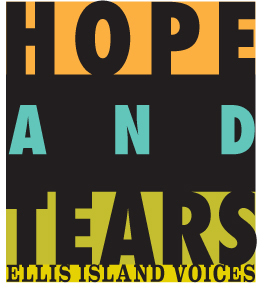
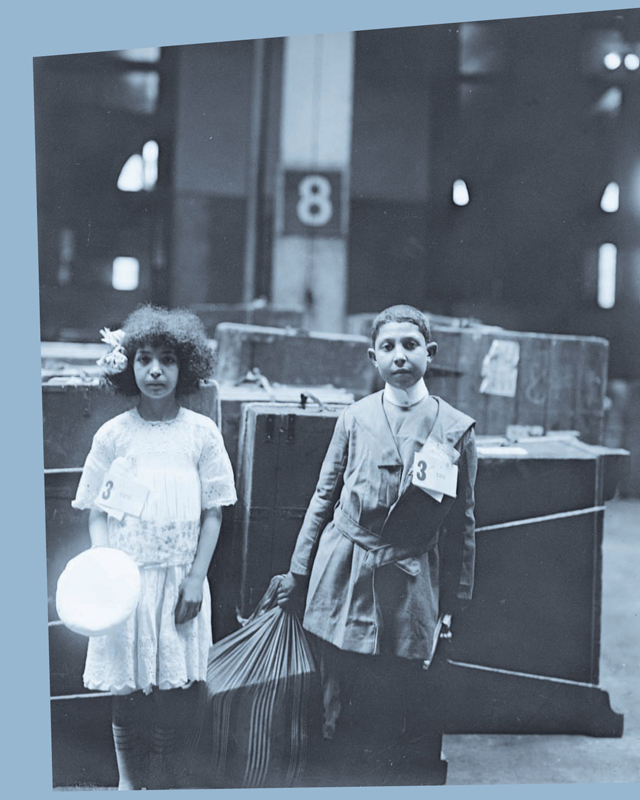
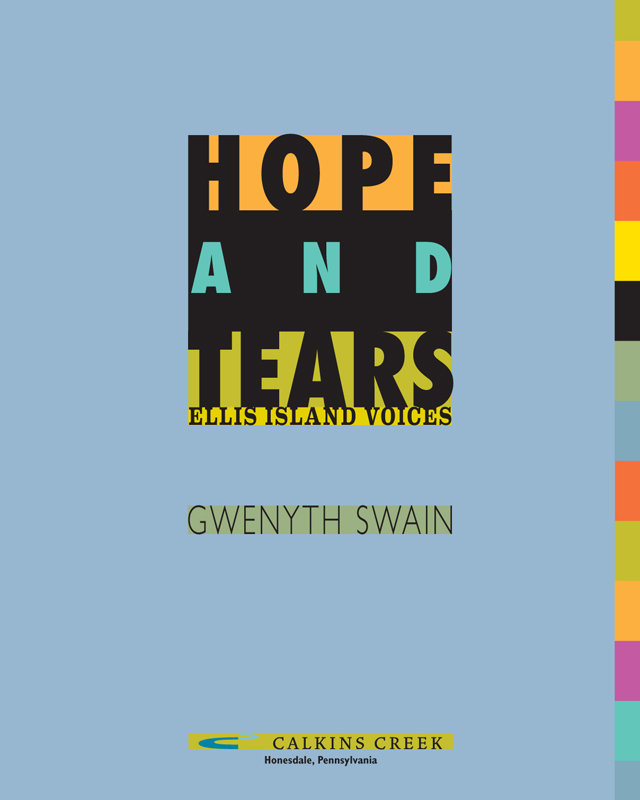 Text copyright 2012 by Gwenyth Swain All rights reserved For information about permission to reproduce selections from this book, please contact . Calkins Creek An Imprint of Boyds Mills Press, Inc. 815 Church Street Honesdale, Pennsylvania 18431 Printed in China ISBN: 978-1-59078-765-6 ISBN: 9781629791784 (ebook) Library of Congress Control Number: 2011940466 First edition 10 9 8 7 6 5 4 3 2 1
Text copyright 2012 by Gwenyth Swain All rights reserved For information about permission to reproduce selections from this book, please contact . Calkins Creek An Imprint of Boyds Mills Press, Inc. 815 Church Street Honesdale, Pennsylvania 18431 Printed in China ISBN: 978-1-59078-765-6 ISBN: 9781629791784 (ebook) Library of Congress Control Number: 2011940466 First edition 10 9 8 7 6 5 4 3 2 1  This activity is made
This activity is made
possible in part by a grant
from the Minnesota State
Arts Board, through an
appropriation by the
Minnesota State
Legislature and a
grant from the National
Endowment for the Arts. Designed by Barbara Grzeslo Production by Margaret Mosomillo Titles and text set in Gill Sans Haikus set in Eames Century Modern To my grandmother, the late Margaret Hutchinson Coman, for sharing her memories of Ellis Island Acknowledgments I wish to acknowledge the help of the following individuals and institutions in the preparation of this book: Jeffrey Dosik and Barry Moreno, librarians, Bob Hope Memorial Library, Ellis Island Immigration Museum, who both have such wonderful stories to share; Janet Levine, oral historian, Ellis Island Oral History Project; Alexandra Lord, historian, Public Health Service; Dorothy Hartman, director of Education and Public Programs, Save Ellis Island; the Minnesota State Arts Board for generous grant support; Patrick Cullom, archivist, Catholic University of America; the Saint Paul Public Library; Winona State University Library, Winona, Minnesota; Jane Resh Thomas and the Monday Morning Writers Group; author Terri DeGezelle; Joe Flahavan and Doug Nienhuis, teachers, Randolph Heights Elementary School, Saint Paul; the students at Twin Cities Academy, who bring their ideas and interests to the library; editor Carolyn Yoder; and my family. GS 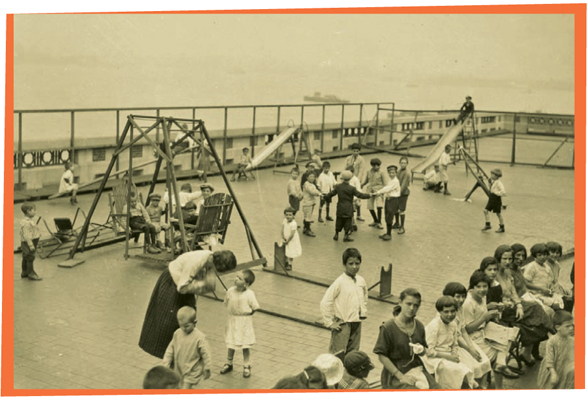 Children on the slides and swings, Ellis Island, 1924. Contents
Children on the slides and swings, Ellis Island, 1924. Contents  Nearing the island: Ellisplace of hope and tears and meetings with joy
Nearing the island: Ellisplace of hope and tears and meetings with joy 
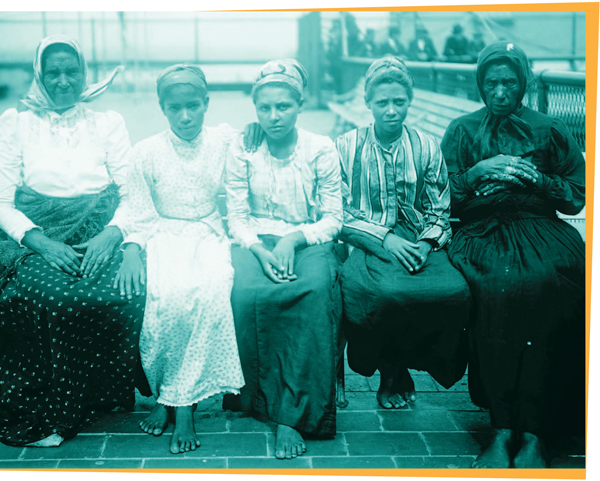 When the door opens
When the door opens
to this new land, watch me race
right in, barefooted 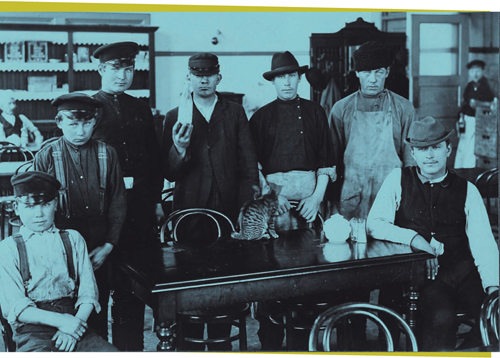 Wear your best hat for
Wear your best hat for
the never-ending waiting...
this is history! 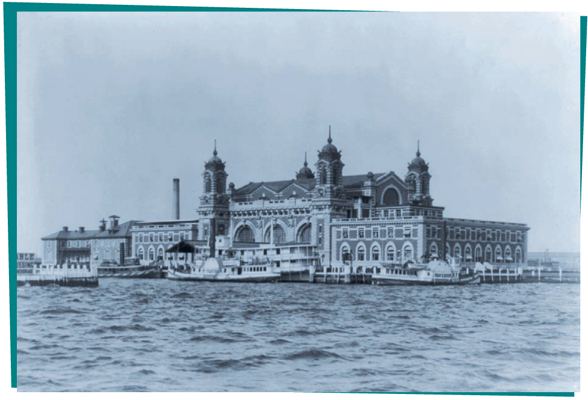 Ellis Island, about 1905, with its cluster of red-brick and
Ellis Island, about 1905, with its cluster of red-brick and
limestone immigration buildings, sits in New York Bay. Introduction M aybe youve heard of Ellis Island before. It once was the largest, busiest immigration point in the United States.
Between 1892 and its closing in 1954, an estimated twelve million immigrants passed through this small island in New York Bay on their way to becoming American citizens. One-quarter of all Americans can trace some part of their ancestry to this place. For me, Ellis Island is a collection of voices. A long time ago, my grandmother shared her memories of visiting the island as a girl in the early 1900s. Grandma had gone there as a tourist, and she mainly remembered the immense crowds. Her visit took place sometime during the peak years of immigration on Ellis (19031914), when as many as five thousand people might have passed through in a single day.
When I visited Ellis Island nearly a century later, I heard more stories at the islands Oral History Division, where countless interviews are stored. I also went to the Ellis Island Library, with its wonderful collections of documents and photographs. The monologues, dialogues, prose poems, and letters that follow grew out of these experiences. Each one can be read silently or performed as a miniplay. Each one reflects the experience of a different person whose life somehow intersected with Ellis Island. Along with these fiction pieces are short factual essays on parts of Ellis Island life and history.
Together, they paint a picture of a real place, vital to our history, and filled with hope and tears. CHAPTER ONE Ellis Islands 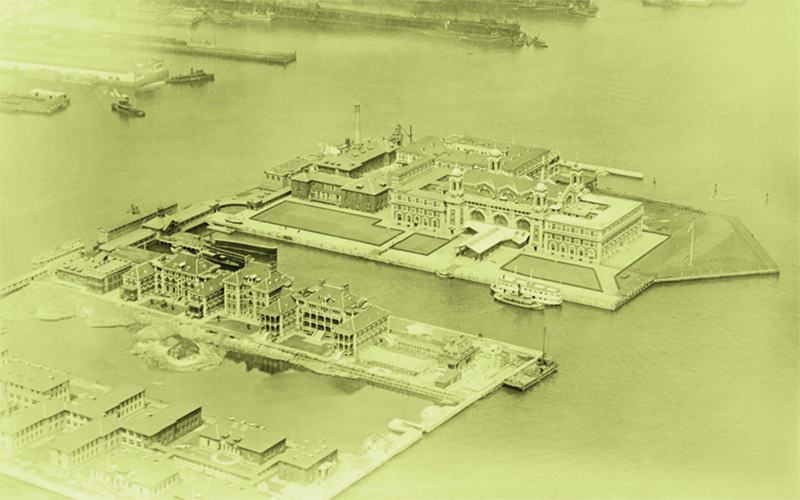 View of Ellis Island, about 1920, showing not one but three separate islands. Two islands in the foreground have since been made into one. T he name Ellis Island is singular, as if it were just one place. But its really plural, a combination of islands. Originally, it was small and flat. Only sea gulls lived there.
View of Ellis Island, about 1920, showing not one but three separate islands. Two islands in the foreground have since been made into one. T he name Ellis Island is singular, as if it were just one place. But its really plural, a combination of islands. Originally, it was small and flat. Only sea gulls lived there.
Lenni Lenape Indians paddled to the tiny island to fish and find oysters. They called it Kioshk, or Gull Island, and they were careful to time their visits. At high tide, they sometimes got wet. Later, in the 1600s, members of the Dutch West India Company in Nieuw Amsterdam (which later became New York) purchased two islands from the Indians. The bigger one is now known as Liberty Island, while the smaller one is called Ellis. The Dutch left the smaller island undisturbed, except to gather oysters there.
Over the years, the island was owned by several different people. In 1774, it was sold to Samuel Ellis, but by 1785, he was trying to get rid of it. The place didnt have the greatest reputation. It had earned the nickname Gibbet Island some years before, when pirates were hanged there, on a gibbet, to die. When the United States government needed to build a fort to defend New York City against a possible British attack in the years before the War of 1812, Mr. Elliss heirs finally found a buyer.
Ellis Island, as people were calling it then, was flat and wet. The government decided to build it up. Workers used landfilldirt brought in by boatto raise the islands level and increase its size. Fort Gibson was built on top of the dirt, but the new fort was never attacked. By 1890, there was no longer any need to defend New York City from British attack. But the need for a good place to process, or check over, immigrants had grown by leaps and bounds.
Ellis Island was the perfect spot for a new immigration center. A channel, deep enough for ferry boats to dock, was created. A grand pinewood immigration station sprouted up in 1892. Some compared the building to an elegant resort hotel. But on the morning of June 15, 1897, that wooden immigration station burned to the ground. Officials quickly decided to rebuild using fireproof brick and limestone.
The grand red-and-white building opened in 1900. Its still standing today but on a much bigger piece of land. Heres how the island grew: First, in 1898 the main island (called Island One) was joined by another island, called Island Two. This island soon housed a hospital for sick immigrants. In 1912, a second hospital on yet another island (Island Three) was completed. The three islands were linked by a narrow spit of land with a covered walkway.
Next page


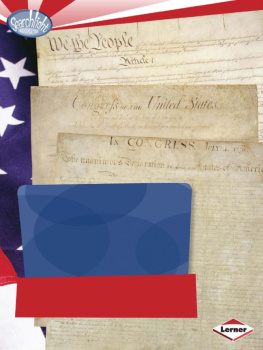



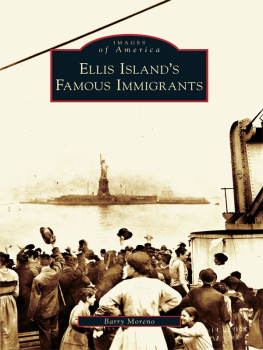

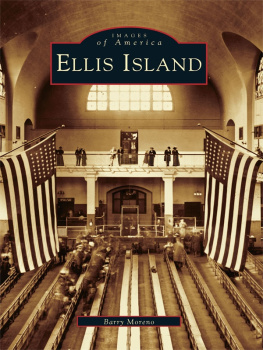
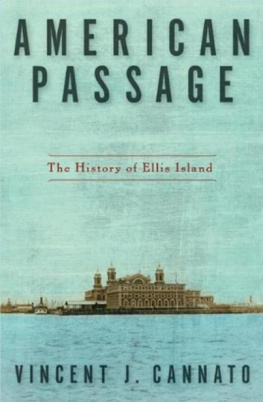

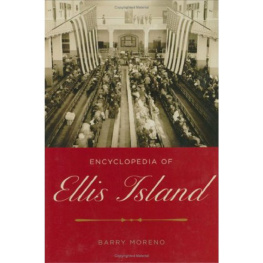


 Text copyright 2012 by Gwenyth Swain All rights reserved For information about permission to reproduce selections from this book, please contact . Calkins Creek An Imprint of Boyds Mills Press, Inc. 815 Church Street Honesdale, Pennsylvania 18431 Printed in China ISBN: 978-1-59078-765-6 ISBN: 9781629791784 (ebook) Library of Congress Control Number: 2011940466 First edition 10 9 8 7 6 5 4 3 2 1
Text copyright 2012 by Gwenyth Swain All rights reserved For information about permission to reproduce selections from this book, please contact . Calkins Creek An Imprint of Boyds Mills Press, Inc. 815 Church Street Honesdale, Pennsylvania 18431 Printed in China ISBN: 978-1-59078-765-6 ISBN: 9781629791784 (ebook) Library of Congress Control Number: 2011940466 First edition 10 9 8 7 6 5 4 3 2 1  This activity is made
This activity is made Children on the slides and swings, Ellis Island, 1924. Contents
Children on the slides and swings, Ellis Island, 1924. Contents 
 When the door opens
When the door opens Wear your best hat for
Wear your best hat for Ellis Island, about 1905, with its cluster of red-brick and
Ellis Island, about 1905, with its cluster of red-brick and View of Ellis Island, about 1920, showing not one but three separate islands. Two islands in the foreground have since been made into one. T he name Ellis Island is singular, as if it were just one place. But its really plural, a combination of islands. Originally, it was small and flat. Only sea gulls lived there.
View of Ellis Island, about 1920, showing not one but three separate islands. Two islands in the foreground have since been made into one. T he name Ellis Island is singular, as if it were just one place. But its really plural, a combination of islands. Originally, it was small and flat. Only sea gulls lived there.